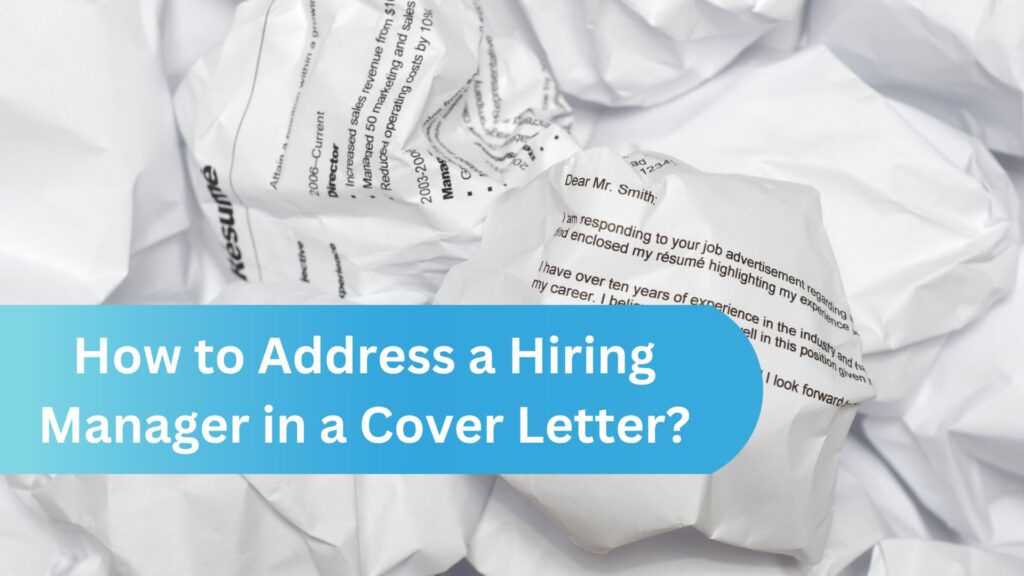When writing a cover letter, the first line a recruiter sees sets the tone for everything that follows. It’s your first impression — and addressing the hiring manager correctly shows professionalism, attention to detail, and genuine interest in the position.
But what if you don’t know the hiring manager’s name? Should you still write Dear Hiring Manager or use To Whom It May Concern? Let’s break down how to address your cover letter in every situation, with examples and practical tips.
Why Your Cover Letter Greeting Matters
Your greeting is small but powerful. It does three things:
-
Creates a personal connection. Addressing someone by name immediately feels more genuine.
-
Shows you’ve done your research. Recruiters notice when you’ve taken time to identify the right contact.
-
Sets a professional tone. A respectful, polished greeting sets you apart from generic applicants.
A careless or outdated greeting like “To Whom It May Concern” can make your cover letter feel impersonal — even if the rest of it is excellent.
Step 1: When You Know the Hiring Manager’s Name
If you know the name of the hiring manager, always use it. This is the best and most professional option.
✅ Examples
-
Dear Ms. Johnson,
-
Dear Mr. Patel,
-
Dear Dr. Chen,
-
Dear Jordan Smith, (if you’re unsure about gender)
🔹 Formatting Tips
-
Use “Dear” — not “Hi” or “Hello.”
-
Include a colon or comma depending on tone (colon is more formal).
-
Double-check the spelling and title before sending.
If the job posting includes the name, use it exactly as shown. If not, check:
-
The company’s “About” or “Team” page
-
LinkedIn (search by job title + company name)
-
The email domain from previous messages
Step 2: When You Can’t Find the Hiring Manager’s Name
Sometimes, no matter how much research you do, you can’t find the name. That’s okay — there are still professional, gender-neutral greetings you can use.
✅ Best Alternatives
-
Dear Hiring Manager,
-
Dear [Department Name] Hiring Team, (e.g., Dear Marketing Hiring Team,)
-
Dear Recruitment Team,
-
Dear Human Resources Department,
-
Dear [Company Name] Team, (e.g., Dear Acme Corp Team,)
These options show that you made an effort to personalize your letter while keeping it professional and inclusive.
🚫 What to Avoid
-
“To Whom It May Concern” — outdated and impersonal
-
“Dear Sir or Madam” — overly formal and gendered
-
“Hey there” or “Hi team” — too casual for professional correspondence
Step 3: How to Find the Hiring Manager’s Name (If You Want Bonus Points)
Spending 5–10 extra minutes trying to find the name can make your application stand out. Here’s how to do it effectively:
-
Check the job posting carefully. Sometimes the contact person’s name is hidden near the bottom.
-
Look on LinkedIn.
-
Search the company name + “HR Manager,” “Recruiter,” or “Hiring Manager.”
-
If you find multiple, use the one related to your role or department.
-
-
Visit the company website. Many organizations list department heads or recruiters under “About Us” or “Team.”
-
Call or email the company.
-
A simple message like, “Hi, I’m applying for the [Job Title] position and would like to address my cover letter correctly — could you please tell me who’s handling recruitment for this role?” works perfectly.
-
Recruiters appreciate initiative and attention to detail.
Step 4: When You’re Applying Online (and No Contact Is Listed)
If you’re submitting your cover letter through an online portal or job board, personalization can be harder. In that case, default to “Dear Hiring Manager” or “Dear [Department] Team.”
Example:
Dear Marketing Hiring Manager,
I’m excited to apply for the Marketing Coordinator position at Acme Corp. My background in digital campaigns and analytics aligns perfectly with your team’s goals.
Even though it’s generic, this version still feels targeted and professional.
Step 5: How to Handle Titles, Gender, and Pronouns (Expanded)
In today’s workplace, sensitivity to gender identity and inclusive communication is no longer optional — it’s expected. Misusing a title like “Mr.” or “Ms.” can unintentionally create an awkward impression or suggest carelessness.
If you’re uncertain about the hiring manager’s gender or preferred title, always err on the side of neutrality.
✅ Best Practice:
Use their full name — for example:
-
Dear Taylor Jordan,
-
Dear Alex Kim,
-
Dear Jordan Lee,
This approach is formal, professional, and avoids assumptions. It also works perfectly across all industries and roles.
If you’re emailing someone whose gender is ambiguous based on their name, do not guess or rely on outdated cues. Instead, check their LinkedIn profile, company bio, or signature — often, you can find pronouns like she/her, he/him, they/them listed directly.
If you still can’t confirm, keep it gender-neutral by using the person’s full name or a team-based greeting (like Dear Hiring Manager).
⚠️ Avoid These Common Mistakes
-
❌ Using “Mr.” or “Ms.” when unsure.
-
❌ Guessing based on first names (e.g., “Dear Mr. Jordan” when Jordan is actually a woman).
-
❌ Using overly casual openings like “Hi Alex!” unless the recruiter has written to you that way first.
A respectful, accurate greeting communicates cultural awareness and professionalism — two qualities employers value highly.
Step 6: Special Cases
Not every hiring process fits neatly into a corporate mold. Depending on where you’re applying, you might need to adjust your tone and greeting slightly to match the organization’s culture.
🏢 When Applying to a Small Business
Small businesses often have informal, tight-knit teams — and hiring may be handled directly by the owner or manager.
If you know who that is, address them directly:
Dear Ms. Roberts,
If the company is very small and no individual contact is listed, you can personalize by using the company name itself:
Dear [Company Name] Team,
Dear [Company Name] Hiring Team,
These greetings still sound personal while acknowledging the team-oriented nature of small businesses.
Tip: A touch of warmth is acceptable for small firms — but always remain professional. Something like “Dear GreenLeaf Design Team,” feels friendly yet polished.
🧑💼 When Applying Through a Recruiter
If you’re working with a recruiter or talent agency, your greeting should reflect that relationship.
If the recruiter referred you directly, address them by name:
Dear [Recruiter’s Name],
Then, in your opening paragraph, mention the referral clearly:
“As recommended by [Recruiter’s Name], I’m writing to express my interest in the [Job Title] position at [Company Name].”
This not only establishes context but also reinforces that your application has a personal endorsement — which increases credibility.
If you’re applying through a recruiting platform or talent agency (e.g., Robert Half, Hays, Indeed Hiring Platform), you can use:
Dear Recruitment Team,
Dear Talent Acquisition Department,
It shows respect for the team evaluating your application.
🧑⚖️ When You’re Applying to a Large Organization
Larger companies typically have multiple hiring managers. In that case, targeting a department-specific greeting works best:
Dear Marketing Hiring Manager,
Dear Engineering Recruitment Team,
Dear Human Resources Department,
This level of personalization demonstrates initiative — even if you don’t have a specific name.
Step 7: Example Cover Letter Openings — The Right and Wrong Way
Your greeting is just the beginning. The first few lines after it should reinforce professionalism and enthusiasm. A great opening shows you’ve researched the company and are genuinely interested — not just sending out templates.
Strong Example
Dear Mr. Rivera,
I was thrilled to see the opening for a Project Coordinator at ClearPath Solutions. Having led multiple cross-functional projects in my current role, I’m confident that my background aligns closely with your team’s goals.
Why it works:
-
It’s personalized and specific.
-
It references the company name and role.
-
It transitions naturally from greeting to introduction.
Weak Example
To Whom It May Concern,
I’m writing to apply for the Project Coordinator position. I believe my skills make me a strong fit for this role.
Why it fails?
-
Generic greeting shows zero personalization.
-
Lacks enthusiasm or specific connection to the company.
-
Feels like a copy-paste application.
Even if your skills are excellent, a weak opening can make your application forgettable. A strong greeting and first paragraph grab attention immediately — and that’s half the battle.
Step 8: Quick Checklist Before You Send Your Cover Letter
Before you hit “Send,” review this checklist to make sure your greeting (and the rest of your letter) hits the mark:
✅ Use “Dear [Name]” whenever possible — It’s the most professional and universally accepted format.
✅ Double-check spelling and titles — Misspelling a name or getting a title wrong is one of the quickest ways to lose credibility.
✅ Avoid outdated or impersonal greetings — “To Whom It May Concern” and “Dear Sir/Madam” feel cold and generic.
✅ Keep your tone professional yet approachable — A formal greeting can pair well with a warm, confident tone in your body text.
✅ Match your greeting to your audience — A startup might appreciate “Dear Product Team,” while a law firm will expect “Dear Mr. [Last Name].”
✅ Proofread your email — A greeting typo (like “Dear Jordon” instead of “Jordan”) can instantly undercut a polished resume.
✅ Check formatting consistency — Your greeting, spacing, and capitalization should align with the rest of your letter for a clean, uniform look.
Final Thoughts: Make Your First Impression Count
Your greeting might seem like a tiny detail — but in a competitive job market, details are what make you stand out.
A personalized greeting tells employers that you’ve taken the time to understand their company, their team, and their culture. It signals effort, curiosity, and professionalism — all before they’ve even read your qualifications.
When possible, always use a specific name. It creates connection and warmth. But when a name isn’t available, a thoughtful, team-based greeting shows respect and intentionality.
Remember: every word in your cover letter contributes to the impression you leave. A polished, inclusive, and well-researched greeting can set the tone for a compelling narrative — one that convinces the employer you’re not just qualified, but also someone they want to work with.
Key Takeaways
-
Use names whenever you can. It makes your cover letter personal and memorable.
-
If you can’t find a name, use a professional alternative like Dear Hiring Manager or Dear [Department] Team.
-
Be inclusive and accurate — never assume gender or title without verification.
-
Customize your greeting to the company’s tone and culture. A formal law firm and a creative agency will expect different levels of formality.
-
Proofread everything. A typo in the greeting can undo an otherwise perfect application.
-
Personalization equals effort — and effort equals attention. Recruiters can always tell when you’ve taken the time to tailor your application.


